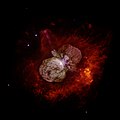Bild:Eta Carinae.jpg
Erscheinungsbild

Grött vun disse Vörschuu: 600 × 599 Pixels. Anner Oplösungen: 240 × 240 Pixels | 480 × 480 Pixels | 769 × 768 Pixels | 1.025 × 1.024 Pixels | 2.015 × 2.013 Pixels.
Originaldatei (2.015 × 2.013 Pixel, Grött: 163 KB, MIME-Typ: image/jpeg)
Datei-Historie
Klick op de Tiet, dat du de Datei ankieken kannst, so as se do utseeg.
| Datum/Tiet | Duumnagelbild | Grött | Bruker | Kommentoor | |
|---|---|---|---|---|---|
| aktuell | 10:41, 18. Dez. 2017 |  | 2.015 × 2.013 (163 KB) | The NMI User | Reverted to version as of 14:14, 1 May 2008 (UTC) |
| 15:45, 13. Mär 2017 |  | 3.000 × 2.998 (1,18 MB) | Leogorgon | larger file size | |
| 15:14, 1. Mai 2008 |  | 2.015 × 2.013 (163 KB) | Vol de nuit | {{Information |Description=(NASA News Release) A huge, billowing pair of gas and dust clouds are captured in this stunning NASA Hubble Space Telescope image of the supermassive star Eta Carinae. Using a combination of image processing techniques (ditheri |
Dateibruuk
Kene Siet bruukt dat Bild.
Allmeen Datei-Bruuk
Disse annern Wikis bruukt disse Datei:
- Bruuk op da.wikipedia.org
- Bruuk op en.wikipedia.org
- Star
- Eta Carinae
- Wikipedia:Selected anniversaries/March 11
- Wikipedia:Today's featured article/March 2017
- Wikipedia:WikiProject Wikipack Africa Content/Wikipedia:Showcase
- Wikipedia:WikiProject WikiFundi Content/Eta Carinae
- Wikipedia:Today's featured article/requests/Eta Carinae
- Wikipedia:Today's featured article/March 12, 2017
- Wikipedia:Main Page history/2017 March 12
- Wikipedia:WikiProject WikiFundi Content/Wikipedia:Showcase
- Wikipedia:Main Page history/2022 March 11
- Wikipedia:Main Page history/2022 March 11b
- Wikipedia:Main Page history/2023 March 11
- Wikipedia:Main Page history/2023 March 11b
- User:2003 LN6/sandbox/Eta Carinae variable
- List of luminous blue variable stars
- Bruuk op en.wikiversity.org
- User:Marshallsumter/Radiation astronomy2/Visuals
- User:Marshallsumter/Radiation astronomy2/Violets
- Stars/Astronomy
- User:Marshallsumter/Radiation astronomy2/Violets/Quiz
- Stars/Sun/Astronomy/Quiz
- User:Marshallsumter/Radiation astronomy/Courses/Principles/Hourly 2
- User:Marshallsumter/Radiation astronomy/Courses/Principles/Final quiz
- Draft:Original research/Io/Quiz
- Titan/Quiz
- Stars/Solar systems/Quiz
- Moon/Quiz
- Earth/Quiz
- User:Marshallsumter/Radiation astronomy/Colors/Quiz
- Volcanoes/Io/Quiz
- Stars/Violets
- User:Marshallsumter/Radiation astronomy2/Stars
- Stars/Violets/Quiz
- Bruuk op es.wikipedia.org
- Bruuk op fr.wikipedia.org
- Bruuk op hi.wikipedia.org
- Bruuk op it.wikibooks.org
- Bruuk op la.wikipedia.org
- Bruuk op mk.wikipedia.org
- Bruuk op ms.wikipedia.org
- Bruuk op my.wikipedia.org
- Bruuk op oc.wikipedia.org
- Bruuk op ru.wikipedia.org
- Bruuk op sk.wikipedia.org
- Bruuk op sr.wikipedia.org
- Bruuk op th.wikipedia.org
Kiek na mehr almeen Bruuk von disse Datei.

